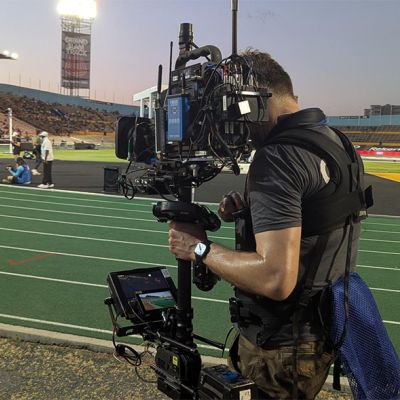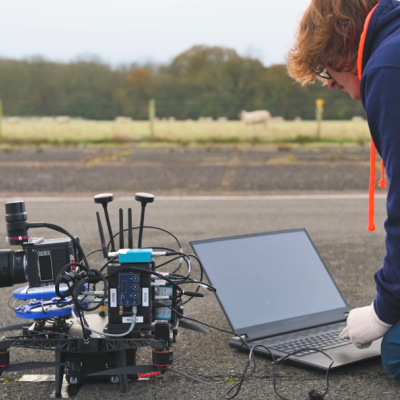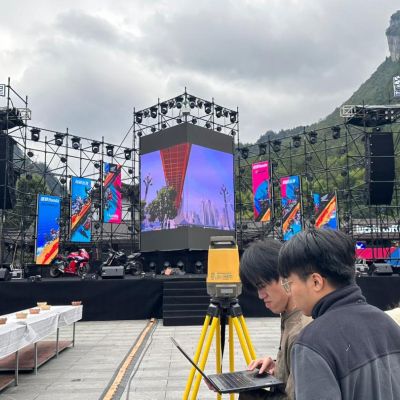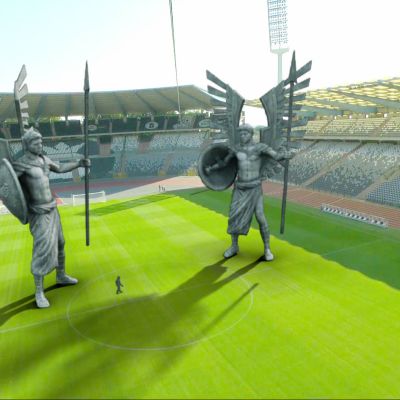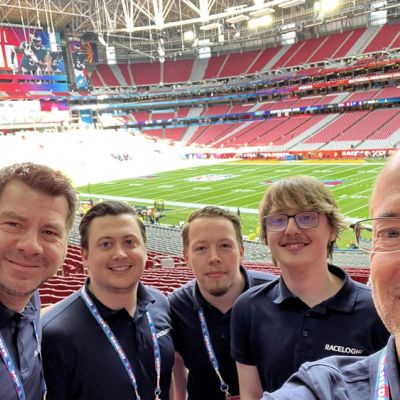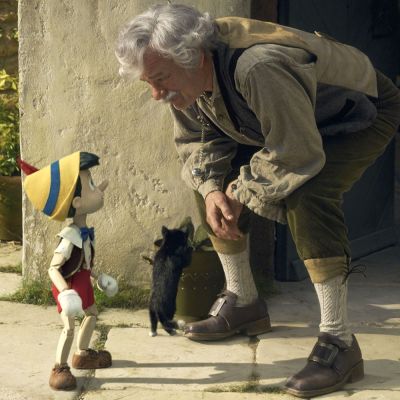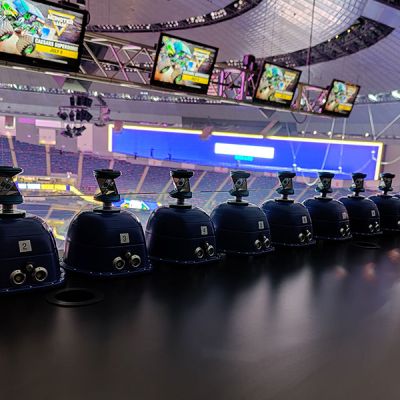SCALABLE / LOW-LATENCY / NO LIGHT CONSTRAINTS
Camera Tracking for Augmented Reality in Film, Broadcast and Virtual Production
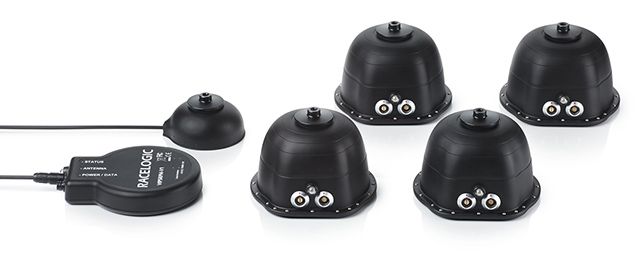

AirPixel is a camera tracking solution for AR in broadcast TV and live events, in-camera VFX on Virtual Productions in LED volumes and for Simulcam in greenscreen studios.
It provides precise position along with tilt/pan/roll values and directly integrates FIZ data and genlock.
AirPixel seamlessly integrates with Unreal Engine and other render platforms such as Brainstorm, Disguise, Pixotope, VizRT, and Zero Density.
Built on advanced ultra-wideband (UWB) and inertial tracking technology, AirPixel is unaffected by lighting conditions.
AirPixel has a fast set-up time, is light, and scales to very large indoor and outdoor venues such as studio hangars and open air stadiums as ambient light has no effect.
Why AirPixel?

Position, Pan, Tilt & Roll (6DOF)
AirPixel provides accurate pan, tilt and roll plus X, Y, Z position up to 100 times a second. Advanced filtering is used, combining inertial sensor and UWB data to significantly reduce drift.

No Lighting Restrictions
AirPixel works in all weather conditions including bright sunlight, rain, mist or total darkness. With an IP rating of 67, the beacons can be safely placed outside without risking weather damage.

Highly Scalable
AirPixel covers stages of virtually unlimited size without any deterioration in position quality. Up to 250 beacons and 5 rovers can be deployed in a single setup. Beacons can be placed up to 50 meters apart.

No Line Of Sight Required
Using radio (UWB) rather than optical tracking, AirPixel beacons can be placed behind a green/blue screen.

FIZ Data / Genlock Integration
AirPixel can read the focus, iris and zoom values from a variety of cameras and controllers. AirPixel integrates FIZ data and genlock to provide a complete data set to the render engine.

Supports Major Rendering Platforms
AirPixel seamlessly integrates with Unreal Engine and other popular rendering solutions such as Pixotope, Disguise d3, Zero Density, Brainstorm, VizRT, and MotionBuilder. Data is output using AirPixel or FreeD protocol.

Quick To Deploy
The initial setup can be done in several hours depending on stage complexity and the re-initialisation takes only 2 minutes after power up.

Low Latency
AirPixel is a low latency system suitable for all real-time applications. All data is processed on camera and transmitted with as little as 20 ms latency.

Small Payload
AirPixel uses a small receiver placed on the camera, plus a compact control unit, weighing a combined 600 g (1.3 lb). No further processing is required.
Ultra-Wideband Positioning Technology
AirPixel works by utilising a collection of stand-alone beacons, which can be battery or permanently powered. Using ultra-wideband radio (UWB) they communicate with an on-camera receiver (rover). The rover calculates its position and orientation using the UWB data and an internal inertial measurement unit (IMU). This data is then processed through an advanced filter algorithm to give an accurate output of X, Y, Z, Pan, Tilt, and Roll.
The rover connects to a lightweight control unit which combines the position data with lens FIZ data, genlocks the output and transmits to the render engine via Ethernet or serial connection. Data is also formatted at this point in either AirPixel proprietary format ideal for use with our custom Live Link plugin, or FreeD format for extended software compatibility.
Permanent or Temporary Installations
To set up the system, beacons are placed around the perimeter of the stage and/ or above the stage at varying heights and locations. The beacons are then surveyed using a high-speed robotic total station and bespoke in-house software. Using this method, it is possible to set the beacon locations with millimetre accuracy, and still complete setup in less than 2 hours for most configurations.
Camera Integration in any conditions
AirPixel works with many camera rigging systems, having been used on dolly, Steadicam, jibs, cranes and cable cams. It also works in any lighting conditions, including total darkness. In addition, we integrate with popular 3rd party products, to provide the best solution for your needs. This means that accurate data can often be provided on shots where traditionally tracking would be difficult or impossible.
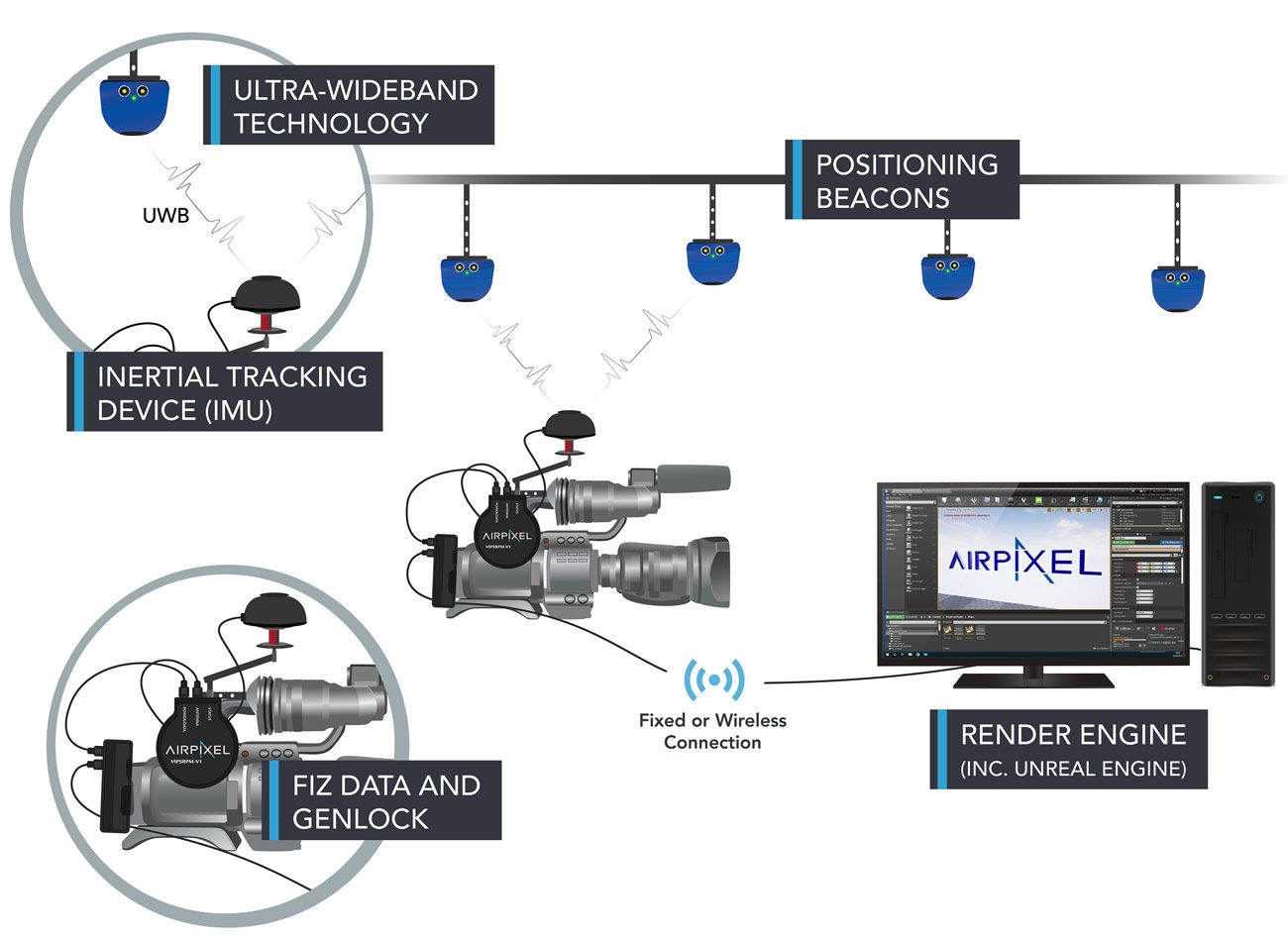
Specifications
| Update rate | max. 100 Hz |
| Output rate Genlocked | 23.98, 24, 25, 29.97, 29.97 Drop, 30,47.95, 48, 50, 59.94, 59.94 Drop, 60 |
| Position accuracy | X: ±2 cm Y: ±2 cm Z: ±5 cm |
| Angular Accuracy | Tilt : ±0.2° Roll: ±0.2° Pan : ±0.5° |
| Latency | 50 ms |
| Positional resolution | 1 mm |
| Protocol support | AirPixel or FreeD |
| Max. tracking speed | 270 km/h; 75 metres per second |
| Max. number of receivers | 5 (per UWB channel) |
| Max. number of beacons | 200 (per UWB channel) |
| Max. coverage (assuming 30 m beacon spacing and square volume) |
390 m x 390 m 152,100 m2 1.6 million ft2 |
| UWB Channels | Channel 4 – 3993.6 MHz ±450 MHz Channel 7 – 6489.6 MHz ±450 MHz |
| UWB Transmit Power | -41.3 dBm/MHz |
| Rover dimensions | 7 x 4 cm |
| Beacon dimensions | 13 x 7.5 cm |
| Power requirements | 7 - 30 V DC, 100 mA |
| IP rating | Beacon: IP67 Rover: TBC |
| Operating Temperature | -20˚C to +60˚C |
| Storage Temperature | -40˚C to +85˚C |
Camera Tracking in Action
Explore how AirPixel is redefining camera tracking across real-world environments. From wide-area camera tracking at major sports events to virtual production camera tracking on LED stages, these case studies highlight the system’s versatility, precision, and seamless integration with AR pipelines.

